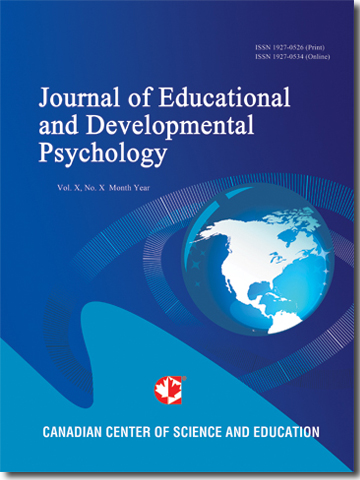Numerical Magnitude Skills in 6-Years-Old Children: Exploring Specific Associations with Components of Executive Function
- Venera Gashaj
- Yoann Uehlinger
- Claudia M. Roebers
Abstract
Little is known about how children learn to associate numbers with their corresponding magnitude and about individual characteristics contributing to performance differences on the numerical magnitude tasks within a relatively homogenous sample of 6-year-olds. The present study investigated the relationships between components of executive function and two different numerical magnitude skills in a sample of 162 kindergartners. The Symbolic Number Line was predicted by verbal updating and switching, whereas the Symbolic Magnitude Comparison was predicted by inhibition. Both symbolic tasks were predicted by visuo-spatial updating. Current findings suggest that visuo-spatial updating underlies young children’s retrieval and processing of numbers’ magnitude.
- Full Text:
 PDF
PDF
- DOI:10.5539/jedp.v6n1p157
Journal Metrics
(The data was calculated based on Google Scholar Citations)
1. Google-based Impact Factor (2021): 1.11
2. h-index (December 2021): 29
3. i10-index (December 2021): 87
4. h5-index (December 2021): N/A
5. h5-median (December 2021): N/A
Index
- Academic Journals Database
- CNKI Scholar
- Copyright Clearance Center
- CrossRef
- Elektronische Zeitschriftenbibliothek (EZB)
- EuroPub Database
- Excellence in Research for Australia (ERA)
- Harvard Library
- Jisc Library Hub Discover
- JournalSeek
- JournalTOCs
- LIVIVO (ZB MED)
- LOCKSS
- MIAR
- Open Access Journals Search Engine(OAJSE)
- PKP Open Archives Harvester
- Publons
- ROAD
- Scilit
- SHERPA/RoMEO
- Standard Periodical Directory
- Stanford Libraries
- Technische Informationsbibliothek (TIB)
- UCR Library
- UoB Library
- WorldCat
- Zeitschriften Daten Bank (ZDB)
Contact
- Carol WongEditorial Assistant
- jedp@ccsenet.org
